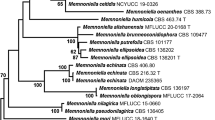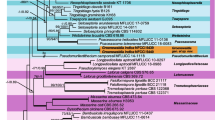Abstract
Two new species of dematiaceous hyphomycetes isolated from senescent leaves of Night-scented Lily, Alocasia odora (plant family: Araceae) are described based on light and scanning electron microscopy as well as LSU rDNA sequence analysis. One of these species observed directly on the leaves and in vitro is placed in genus Parastenella because of morphological characteristics. The other species characterized in vitro only is accommodated in the genus Ramichloridium. Molecular data indicate a close relationship of both species with Ramichloridium musae within the Mycosphaerellaceae (Capnodiales, Dothideomycetidae, Dothideomycetes).








Similar content being viewed by others
References
Abliz P, Fukushima K, Takizawa K, Nishimura K (2004) Identification of pathogenic dematiaceous fungi and related taxa based on large subunit ribosomal DNA D1/D2 domain sequence analysis. FEMS Immunol Med Microbiol 40:41–49
Arzanlou M, Groenewald JZ, Gams W, Braun U, Shin H-D, Crous PW (2007) Phylogenetic and morphotaxonomic revision of Ramichloridium and allied genera. Stud Mycol 58:57–93
Arzanlou M, Groenewald JZ, Fullerton RA, Abeln ECA, Carlier J, Zapater M-F, Buddenhagen IW, Viljoen A, Crous PW (2008) Multiple gene genealogies and phenotypic characters differentiate several novel species of Mycosphaerella and related anamorphs on banana. Persoonia 20:19–37
Braun U, Hill CF, Schubert K (2006) New species and new records of biotrophic micromycetes from Australia, Fiji, New Zealand and Thailand. Fungal Divers 22:13–55
Butin H (1996) Krankheiten der Wald- und Parkbäume, 3rd edn. Thieme Verlag, Stuttgart/New York
Chen J-L (1994) Taxonomic study of the hyphomycetes, Deuteromycotina from Taiwan. Ph.D. thesis, Department of Plant Pathology and Entomology, National Taiwan University, Taipei, Taiwan
Crous PW (2009) Taxonomy and phylogeny of the genus Mycosphaerella and its anamorphs. Fungal Divers 38:1–24
Crous PW, Summerell BA, Carnegie A, Mohammed C, Himaman W, Groenewald JZ (2007a) Foliicolous Mycosphaerella spp. and their anamorphs on Corymbia and Eucalyptus. Fungal Divers 26:143–185
Crous PW, Mohammed C, Glen M, Verkley GJM, Groenewald JZ (2007b) Eucalyptus microfungi known from culture. 3. Eucasphaeria and Sympoventuria genera nova, and new species of Furcaspora, Harknessia, Heteroconium and Phacidiella. Fungal Divers 25:19–36
Crous PW, Braun U, Groenewald JZ (2007c) Mycosphaerella is polyphyletic. Stud Mycol 58:1–32
David JC (1997) A contribution to the systematics of Cladosporium. Revision of the fungi previously referred to Heterosporium. Mycol Pap 172:1–157
Domsch KH, Gams W, Anderson T-H (2007) Compendium of Soil Fungi. 2nd edn. taxonomically revised by W. Gams. IHW Verlag, Eching, Germany
Dornelo-Silva D, Pereira-Carvalho R de, Dianese JC (2008) New Stenella and Parastenella species from the Brazilian cerrado. Mycologia 99:753–764 (published online 2007)
Ellis MB (1967) Dematiaceous hyphomycetes. VIII. Periconiella, Trichodochium etc. Mycol Pap 111:1–46
Govaerts R, Frodin DG (2002) World checklist and bibliography of Araceae (and Acoraceae). Royal Botanic Gardens, Kew
Guo Y-L (2001) New species and new records of fungi from tropical China: Hyphomycetes. Mycotaxon 77:343–348
de Hoog GS (1977) The black yeasts and allied Hyphomycetes. Rhinocladiella and allied genera. Stud Mycol 15:1–140
de Hoog GS, Rahman MA, Boekhout T (1983) Ramichloridium, Veronaea and Stenella: generic delimitation, new combinations and two new species. Trans Br Mycol Soc 81:485–490
Hsu T-W, Wang J-C, Kuoh C-S (2000) Alocasia (Schott) G. Don. In: Huang T-C (ed) Flora of Taiwan, Vol. 5, 2nd edn. Department of Botany, National Taiwan University, Taipei, pp 667–669
Huang WY, Cai YZ, Hyde KD, Corke H, Sun M (2008) Biodiversity of endophytic fungi associated with 29 traditional Chinese medicinal plants. Fungal Divers 33:61–75
Huang WY, Cai YZ, Surveswaran S, Hyde KD, Corke H, Sun M (2009) Molecular phylogenetic identification of endophytic fungi isolated from three Artemisia species. Fungal Divers 36:69–88
Hunter GC, Crous PW, Wingfield BD, Pongpanich K, Wingfield MJ (2006a) Pseudocercospora flavomarginata sp. nov. from Eucalyptus leaves in Thailand. Fungal Divers 22:71–90
Hunter GC, Wingfield BD, Crous PW, Wingfield MJ (2006b) A multi-gene phylogeny for species of Mycosphaerella occurring on Eucalyptus leaves. Stud Mycol 55:147–161
Kirschner R, Sampaio JP, Gadanho M, Weiß M, Oberwinkler F (2001) Cuniculitrema polymorpha (Tremellales, gen. nov. and sp. nov.), a heterobasidiomycete vectored by bark beetles, which is the teleomorph of Sterigmatosporidium polymorphum. Antonie van Leeuwenhoek 80:149–161
Matsushima T (1980) Matsushima Mycological Memoirs No. 1. Saprophytic Microfungi from Taiwan, Part 1. Hyphomycetes. Matsushima Fungus Collect., Kobe, Japan, 82 p
Mohali S, Slippers B, Wingfield MJ (2007) Identification of Botryosphaeriaceae from Eucalyptus, Acacia and Pinus in Venezuela. Fungal Divers 25:103–125
Morgan-Jones G (1980) Notes on hyphomycetes. XXXV. Stenellopsis gen. nov. Mycotaxon 10:405–408
Morgan-Jones G (1998) Notes on hyphomycetes. LXXIV. Concerning Parastenella magnoliae, its phylogenetic affinity, and the relationship between it and its host, Magnolia grandiflora. Mycotaxon 66:421–428
Ohori A, Endo S, Sano A, Yokoyama K, Yarita K, Yamaguchi M, Kamei K, Miyaji M, Nishimura K (2006) Rapid identification of Ochroconis gallopava by a loop-mediated isothermal amplification (LAMP) method. Vet Microbiol 114:359–365
Phengsintham P, Hyde KD, Braun U (2009). Cercospora and allied genera from Laos - 1: Notes on Zasmidium (Stenella s. lat.). Cryptogamie, Mycologie 30:243–262
Raus T (2003) “Viele Köche verderben den Brei”–H. KOCH, H. P. G. KOCH, K. KOCH, W. KOCH und W. D. J. KOCH als Gefäßpflanzen-Autoren in europäischen Basisfloren und Standardlisten. Feddes Repert 114:397–428
Sánchez Márquez S, Bills GF, Zabalgogeazcoa I (2008) Diversity and structure of the fungal endophytic assemblages from two sympatric coastal grasses. Fungal Divers 33:87–100
Sarbajna KK, Chattopadhyay BK (1991) New Stenella species from India. J Mycopathol Res 29:31–38
Schubert K, Braun U (2005) Taxonomic revision of the genus Cladosporium s. lat. 1. Species reallocated to Fusicladium, Parastenella, Passalora, Pseudocercospora and Stenella. Mycological Progress 4:101–109
Shenoy BD, Jeewon R, Hyde KD (2007) Impact of DNA sequence-data on the taxonomy of anamorphic fungi. Fungal Divers 26:1–54
Siboe GM, Kirk PM, Cannon PF (1999) New dematiaceous hyphomycetes from Kenyan rare plants. Mycotaxon 73:282–302
Soares DJ, Barreto RW (2008) Fungal pathogens of the invasive riparian weed Hedychium coronarium from Brazil and their potential for biological control. Fungal Divers 28:85–96
Sutton BC, Cole GT (1983) Thozetella (hyphomycetes): an exercise in diversity. Trans Br Mycol Soc 81:97–107
Tamura K, Dudley J, Nei M, Kumar S (2007) MEGA4: Molecular Evolutionary Genetics Analysis (MEGA) software version 4.0. Mol Biol Evol 24:1596–1599
Wulandari NF, To-anun C, Hyde KD, Duong LM, de Gruyter J, Meffert JP, Groenewald JZ, Crous PW (2009) Phyllosticta citriasiana sp. nov., the cause of Citrus tan spot of Citrus maxima in Asia. Fungal Divers 34:23–39
Yang W-Q (2002) Magical medicinal herbs, vol. 3. Linyu, Taipei
Zheng X-H, Qi P-K, Jiang Z-D (2001) Identification on the fungal diseases of ornamental plants (Araceae) in Guangzhou region–I. Journal of South China Agricultural University 22:39–41 (in Chinese)
Zhou XD, Xie YJ, Chen SF, Wingfield MJ (2008) Diseases of eucalypt plantations in China: challenges and opportunities. Fungal Divers 32:1–7
Acknowledgements
We thank S.-H. Wu for arranging the collection trip to Chitou, Taiwan, M. Ruppel for technical assistance with SEM, C.-L. Hou for providing Chinese literature, and M. Piepenbring for the facilities in Frankfurt, Germany. The study was supported by the National Science Council of Taiwan (NSC 95-2745-B-218-004-URD) and the German Academic Exchange Service (DAAD).
Author information
Authors and Affiliations
Corresponding author
Rights and permissions
About this article
Cite this article
Kirschner, R., Chen, CJ. Two new species of Ramichloridium-like hyphomycetes from senescent leaves of Night-scented Lily (Alocasia odora) in Taiwan. Fungal Diversity 40, 41–50 (2010). https://doi.org/10.1007/s13225-009-0002-z
Received:
Accepted:
Published:
Issue Date:
DOI: https://doi.org/10.1007/s13225-009-0002-z




